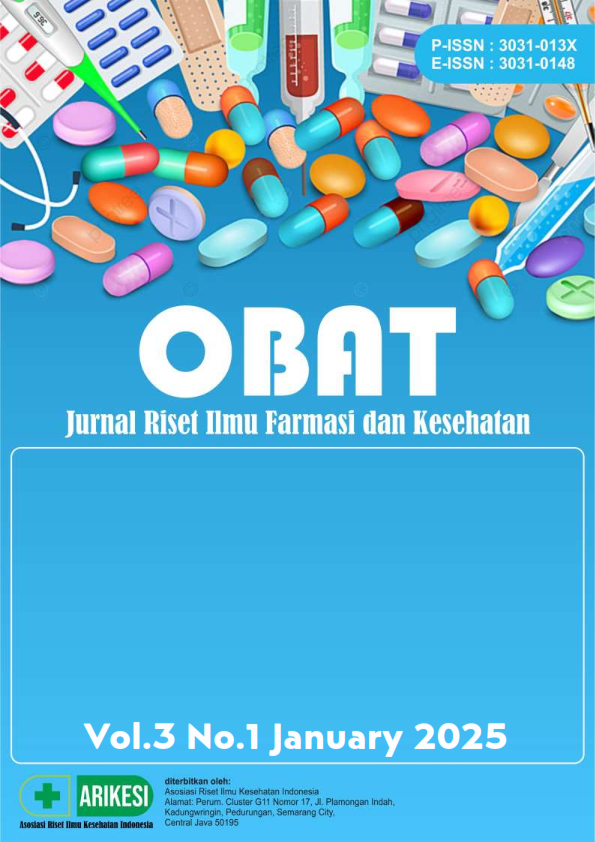Pemanfaatan Rimpang Lengkuas Merah (Alpinia Purpurata K.Schum) sebagai Fungisida Tanaman Selada yang Menopang Inovasi Green Chemistry
DOI:
https://doi.org/10.61132/obat.v3i1.913Keywords:
Biofungicide, Fungicide, Green Chemistry, Red Galangal, Rhizoctonia SolaniAbstract
Indonesia is a country rich in useful biodiversity, such as red galangal (Alpinia purpurata K.Schum). The antibacterial and antifungal activity of the compounds isolated from the red galangal rhizome is the beginning of a new innovation to implement the concept on plants. The content of 1,8 sineol and eugenol in it makes red galangal rhizome can be used as a fungicide on lettuce plants. The widespread use of chemical-based pesticides can harm farmers and the environment with repeated exposure and over a long period of time. So biofungicide innovation is needed that can support the concept of Green Chemistry. The purpose of this study is to determine the effectiveness of red galangal rhizome extract as a fungicide on lettuce plants, as well as to analyze and determine under what conditions the fungicide from red galangal rhizome extract is optimal in eradicating Rhizoctonia Solani fungus on lettuce plants. This research was conducted experimentally using a completely randomized design (CRD) with 10 treatments. All data were tested for normality followed by homogeneity test and all data were found to be normally distributed and homogeneous. Data were analyzed with parametric statistical tests using one-way ANOVA tests and further tests using Tukey with an error rate of 10% to determine whether there was an effect of the treatment tested on the material. The results of this study indicate that red galangal rhizome extract is effective in eradicating Rhizoctonia Solani fungus on lettuce plants with an optimum concentration of 50%.
Downloads
References
Aggeli, F., Ziogas, I., Gziki, D., Fragkogeorgi, G. A., & Tjamos, S. E. (2020). Novel biocontrol agents against Rhizoctonia solani and Sclerotinia sclerotiorum in lettuce. BioControl, 65, 763-773. https://doi.org/10.1007/s10526-020-10043-w
Ahmad, A., Riaz, S., Farooq, R., Ahmed, M., & Hussain, N. (2023). Alpinia Officinarum (Galangal): A beneficial plant. Journal of Medical Public Health, 4, 1057.
Aisy, D. U. R., Adawiyah, R., Rozaliyani, A., Estuningtyas, A., & Fadilah, F. (2023). The antifungal activities of Syzygium aromaticum and Alpinia purpurata extracts against Candida krusei: Bioactivity tests, molecular modeling, and toxicity tests. Asian Pacific Journal of Cancer Prevention, 24(10), 3403. https://doi.org/10.31557/APJCP.2023.24.10.3403
Andi, N. I. (2023). Uji efektivitas kombinasi ekstrak lengkuas merah (Alpinia purpurata K. Schum) dan lengkuas putih (Alpinia galanga L. Wild) terhadap pertumbuhan Candida albicans. Fito Medicine: Journal of Pharmacy and Sciences.
Fenibo, E. O., Ijoma, G. N., Nurmahome, W., & Matambo, T. (2022). The potential and green chemistry attributes of biopesticides for sustainable agriculture. Sustainability, 14(21), 14417. https://doi.org/10.3390/su142114417
Haryati, N. A., & Erwin, C. S. (2015). Uji toksisitas dan aktivitas antibakteri ekstrak daun merah (Syzygium mytifolium Walp) terhadap bakteri Staphylococcus aureus dan Escherichia coli. Jurnal Kimia Mulawarman, 13(1), 35-39.
Hassan, O., & Chang, T. (2021). First report of damping-off of ovate-leaf atractylodes caused by Rhizoctonia solani AG-5 in South Korea. Mycobiology, 49, 1-4. https://doi.org/10.1080/12298093.2021.1873900
Marliana, E., & Saleh, C. (2011). Uji fitokimia dan aktivitas antibakteri ekstrak kasar etanol, fraksi heksana, etil asetat, dan metanol dari buah labu air (Lagenaria siceraria (Moliana) Standl). Jurnal Kimia Mulawarman, 8(2), 63-69.
Meyer, V., Schmidt, B., Pohl, C., Cerimi, K., Schubert, B., Weber, B., ... & Volpato, A. (2020). Mind the fungi. In Universitätsverlag der Technischen Universität Berlin, p. 151. https://doi.org/10.14279/depositonce-10350
Molika, M., Kanjanamaneesathian, M., & Mongkol, R. (2019). Efficacy of ethanolic extracts of galangal (Alpinia galanga) in inhibiting the mycelial growth of Fusarium sacchari and Curvularia lunata and their phytotoxicity on pak choi (Brassica rapa var. chinensis). In International Symposium on Botanical Gardens and Landscapes, 1298, 391-396. https://doi.org/10.17660/ActaHortic.2020.1298.54
Nurkanti, M., Halimah, M., Silfister, Y., & Suganda, H. (2020). Potensi ekstrak lengkuas (Alpinia purpurata K. Schum) sebagai fungisida terhadap jamur Alternaria sp. pada tanaman jeruk. Biotropic: The Journal of Tropical Biology, 4(2), 111-118. https://doi.org/10.29080/biotropic.2020.4.2.111-118
Rialita, T., Radiani, H., & Alfiah, D. (2019). Antimicrobial activity of the combination of red galangal (Alpinia purpurata K. Schum) and cinnamon (Cinnamomum burmanii) essential oils on Escherichia coli and Staphylococcus aureus bacteria. Journal of Physics: Conference Series, 1217(1), 012132. https://doi.org/10.1088/1742-6596/1217/1/012132
Downloads
Published
How to Cite
Issue
Section
License
Copyright (c) 2024 OBAT: Jurnal Riset Ilmu Farmasi dan Kesehatan

This work is licensed under a Creative Commons Attribution-ShareAlike 4.0 International License.





